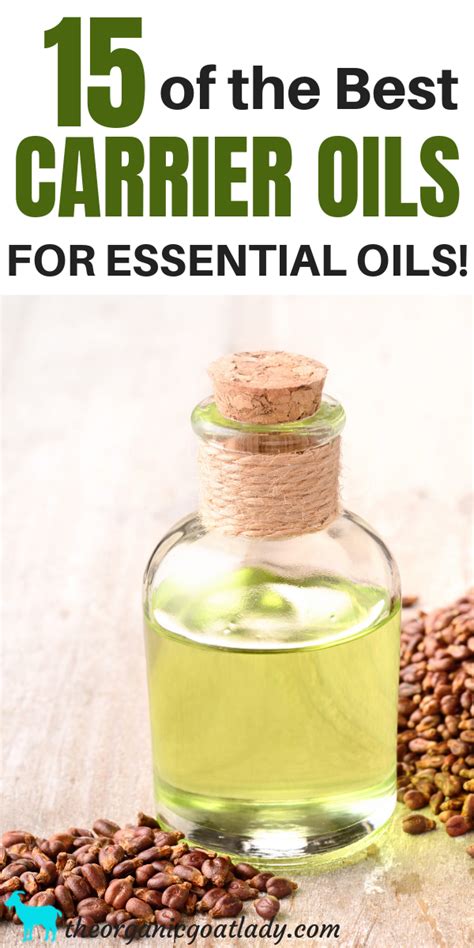Essential oils have been a staple in traditional medicine for centuries, offering a wide range of therapeutic benefits. However, these potent liquids need to be diluted before applying them to the skin to avoid potential irritation or adverse reactions. This is where carrier oils come into play, offering a safe base for essential oil use.

Understanding Carrier Oils
Carrier oils, also known as base oils or vegetable oils, are plant-derived liquids that help dilute essential oils and facilitate their absorption into the skin. They are typically derived from nuts, seeds, or fruits and possess various properties, such as moisturizing, nourishing, and protecting the skin.
According to the National Association for Holistic Aromatherapy, approximately 90% of essential oil blends contain carrier oils as a base. This highlights the importance of selecting the right carrier oil to maximize the benefits of essential oils.
Choosing the Right Carrier Oil
When choosing a carrier oil, consider the following factors:
- Skin Type: Different skin types require different types of oils. For example, dry skin benefits from richer oils like coconut oil, while oily skin prefers lighter oils like jojoba oil.
- Desired Benefits: Some carrier oils have specific therapeutic properties. For instance, almond oil is known for its anti-aging effects, while grapeseed oil is praised for its anti-inflammatory qualities.
- Essential Oil Blend: Certain carrier oils blend better with specific essential oils. For example, coconut oil pairs well with citrus oils, while jojoba oil enhances the effects of floral scents.
Benefits of Using Carrier Oils
Incorporating carrier oils into your essential oil routine offers numerous advantages:
- Dilution: Carrier oils dilute essential oils, making them safe for topical application without compromising their therapeutic benefits.
- Enhanced Absorption: Carrier oils help essential oils penetrate the skin more effectively, allowing them to deliver their effects more efficiently.
- Moisturization: Carrier oils provide nourishment and hydration to the skin, leaving it feeling soft and supple.
- Protection: Carrier oils form a protective barrier on the skin, shielding it from environmental stressors and irritants.
Common Carrier Oils and Their Properties
The table below lists some of the most commonly used carrier oils and their key properties:
| Carrier Oil | Properties |
|---|---|
| Coconut Oil | Highly moisturizing, anti-inflammatory, antibacterial |
| Jojoba Oil | Lightweight, non-greasy, similar to the skin’s natural sebum |
| Almond Oil | Rich in vitamin E, anti-aging, nourishing |
| Grapeseed Oil | Anti-inflammatory, antioxidant, lightweight |
| Argan Oil | Rich in essential fatty acids, moisturizing, anti-aging |
Essential Oil Dilution Ratios
The recommended dilution ratio for essential oils varies depending on the oil and the desired application. It is generally advised to use a dilution of 2-5% for most purposes, which equates to 2-5 drops of essential oil per 10 ml of carrier oil.
For example, to create a 2% dilution for lavender oil, you would mix 2 drops of lavender oil with 98 drops of carrier oil.
Creative Applications for Essential Oil Carrier Oils
Beyond traditional topical applications, essential oil carrier oils can be incorporated into various creative ways to enhance well-being:
- DIY Blends: Create customized essential oil blends tailored to your specific needs by mixing different carrier oils with complementary essential oils.
- Massage Oils: Blend carrier oils with relaxing essential oils, such as lavender or chamomile, for a soothing and therapeutic massage experience.
- Bath Oils: Add a few drops of essential oils to a carrier oil base and disperse it into your bathwater for a relaxing and aromatic soak.
- Hair Care: Mix carrier oils with nourishing essential oils, like rosemary or peppermint, and apply them to your scalp and hair as a pre-shampoo treatment.
- Room Diffusers: Dilute essential oils in a carrier oil and add it to your diffuser to create a calming or invigorating atmosphere.
Effective Strategies for Using Essential Oil Carrier Oils
To make the most of your essential oil carrier oils, consider these effective strategies:
- Patch Test: Always perform a patch test on a small area of skin before applying essential oils to ensure there are no allergic reactions.
- Start Slowly: Begin with a low dilution ratio and gradually increase the concentration as needed to avoid skin irritation.
- Store Properly: Store essential oil blends in dark glass bottles in a cool, dark place to preserve their potency.
- Choose Quality Oils: Opt for high-quality, organic essential oils and carrier oils to derive maximum benefits.
Conclusion
Essential oil carrier oils are invaluable companions in your aromatherapy journey. By understanding their properties, choosing the right oil for your needs, and following safe dilution practices, you can harness the full therapeutic potential of essential oils while nourishing and protecting your skin. Whether you’re seeking relaxation, rejuvenation, or improved well-being, incorporating essential oil carrier oils into your routine is a transformative experience.
